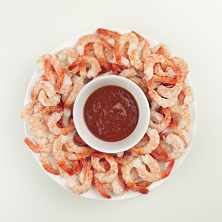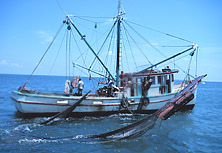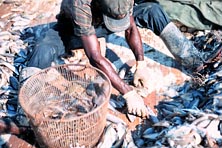Brown Shrimp (Farfantepenaeus aztecus)
- Population levels of brown shrimp are high, and overfishing is not occurring.
- Commercial fisheries for shrimp continue to work to reduce the harmful impacts of bycatch of non-target species, including red snapper.
- Shrimp is low in saturated fat and is a very good source of protein, selenium, and vitamin B12. For more information, see Nutrition Facts. (USDA)
- Only about 10% of the shrimp consumed in the U.S. are captured. The rest are imported, and most are grown in aquaculture. For more information on shrimp imports see the Trade page.
|
 |
 |
 |
 |
| Nutrition Facts |
| Servings 1 |
| Serving Weight
100 g |
 |
| Amount Per Serving |
 |
| Calories 106 |
 |
| Total Fat |
1.73 g |
 |
| Total Saturated Fatty Acids |
0.328 g |
 |
| Carbohydrate |
0.91 g |
| Sugars |
0 g |
| Total Dietary
Fiber |
0 g |
 |
| Cholesterol |
152 mg |
 |
| Selenium |
38 mcg |
 |
| Sodium |
148 mg |
 |
| Protein |
20.31 g |
 |
|
 |
 Sea turtle escaping a shrimp net through a Turtle Excluder Device (TED). Shrimping has significant interaction with sea turtles. Shrimp trawlers must comply with federal sea turtle conservation requirements, including the use of TEDs.
Sea turtle escaping a shrimp net through a Turtle Excluder Device (TED). Shrimping has significant interaction with sea turtles. Shrimp trawlers must comply with federal sea turtle conservation requirements, including the use of TEDs.
|
 |
Did you know?
The commercial shrimp fishery is one of the most economically important fisheries in the southeast Atlantic and Gulf of Mexico. The shrimp industry is based almost entirely on three shallow-water species of the family Penaeidae: white, brown, and pink shrimp.
Brown shrimp are also known as brownies, green lake shrimp, red shrimp, redtail shrimp, golden shrimp, native shrimp, and, in North Carolina, summer shrimp.
Brown shrimp bury themselves in the substrate during the day and are active at night.
|
|
| |
 |
|
A shrimp trawler off the coast of Galveston, Texas. A net is towed by the boat and retrieved when full.
|
 |
|
A commercial fisherman on the east coast of Florida separating shrimp from bycatch.
|
|
Sustainability Status
Biomass: Biomass estimates are not as meaningful for shrimp management as they are with management of most other stocks. See the Biomass and landings section below.
Overfishing: No
Overfished: No
Fishing and habitat: Trawling can affect the seabed in a variety of ways. Individual impacts may be relatively minor, but the cumulative effect and intensity of trawling may have long-term effects on bottom communities. These effects also depend upon site-specific characteristics of the local ecosystem such as bottom type, water depth, community type, gear type, and natural disturbances. Trawling is prohibited in areas supporting coral reefs and other known areas of high-relief or significant biological communities. In the Gulf of Mexico, a "weak-link" is required in the tickler chain to allow it to drop away if the chain gets hung up on natural bottom structures.
Bycatch: Bycatch varies by depth and area fished. In the Gulf of Mexico, more than 450 groups of organisms are taken as bycatch in shrimp trawls. By weight, approximately 67 percent of catch is finfish, 16 percent is commercial shrimp, and 17 percent is invertebrates. Atlantic croaker and longspine porgies are the two most dominant species taken in Gulf shrimp trawls. Red snapper comprise a small portion of overall shrimp trawl bycatch in the Gulf (about 0.5 percent of the overall catch), but this bycatch reduces survival of these fish to the directed fishery. In the South Atlantic, shrimp account for approximately 20% of the total catch by weight. Finfish account for 47% of the total shrimp trawl catch, while crustaceans and other invertebrates account for the remainder of the catch. Important species caught as bycatch in the South Atlantic include spot, Atlantic croaker, weakfish and Spanish mackerel. Sea turtles are also caught as bycatch in shrimp trawls. Shrimp trawlers must comply with federal sea turtle conservation requirements, including the use of Turtle Excluder Devices (TEDs). Shrimp trawlers also must use bycatch reduction devices (BRDs) in shrimp trawls to reduce finfish bycatch. In February 2008, NMFS implemented a new rule that changed BRD certification criteria to allow for certification of new, more effective BRDs.
Aquaculture: Brown shrimp is not currently produced in aquaculture in the U.S., but about 8 million pounds of Pacific Whiteleg Shrimp (Litopenaeus vannamei) are grown in U.S. aquaculture each year.
|
Science and Management
In the South Atlantic region, brown shrimp are managed through the South Atlantic Fishery Management Council's (SAFMC) Shrimp Fishery Management Plan (FMP), implemented in 1993. The FMP was amended in 1996 to include brown shrimp. The FMP allows North and South Carolina, Georgia, and east Florida to request a closure in federal waters adjacent to closed state waters for brown, pink, or white shrimp following severe cold weather. Certified bycatch reduction devices (BRDs) are required in all penaeid (pink, white and brown) shrimp trawls in the South Atlantic EEZ to reduce shrimp trawl bycatch.
In the Gulf of Mexico, brown shrimp are managed through the Gulf of Mexico Fishery Management Council's Shrimp FMP, implemented in 1981. The goal of the FMP is to enhance yield, in volume and value, by deferring harvest of small shrimp to provide for growth. In cooperation with the State of Texas, the shrimp fishery off Texas is closed annually to allow brown shrimp to grow to a larger and more valuable size prior to harvest and to prevent waste of brown shrimp that might otherwise be discarded due to their small size. The annual closure ranges from 45 to 90 days and is based upon biological sampling conducted by the Texas Parks and Wildlife Department. NOAA opens federal waters when Texas opens its territorial waters. This FMP also established reporting systems for vessels dealers, and processors. Bycatch reduction devices were first required in the shrimp trawl fishery in the late 1990s to reduce bycatch of red snapper and other finfish.
NOAA's National Marine Fisheries Service (NMFS) is working on new BRD designs and certification criteria for South Atlantic and Gulf shrimp trawl vessels to further minimize bycatch. Shrimp trawls also interact with sea turtles. Shrimp trawlers must comply with federal sea turtle conservation requirements, including the use of Turtle Excluder Devices (TEDs).
The condition of the brown shrimp stock is monitored annually and has not been classified as being overfished for over 40 years.
|
Life History and Habitat
Life history, including information on the habitat, growth, feeding, and reproduction of a species, is important because it affects how a fishery is managed. Fast growing, short-lived species, like brown shrimp, usually have a relatively quick response to management measures. As a result, fisheries managers can alter fishing regulations and, subsequently, offset natural and human-induced fluctuations in brown shrimp biomass more quickly than for slower-growing species.
- Geographic range: Brown shrimp are found worldwide in tropical and temperate waters. In the U.S., brown shrimp range from off Martha's Vineyard, Massachusetts, to the Florida Keys and northward into the Gulf to the Sanibel grounds, and reappear near Apalachicola Bay and occur around the Gulf Coast to northwestern Yucatan in Mexico.
- Habitat: Shallow water; occur in commercial quantities in waters as deep as 361 feet but are most abundant in water less than 180 feet. Postlarval shrimp occupy nursery areas generally dominated by marsh grass Spartina alterniflora in the South Atlantic and Juncus spp.in the Gulf. They prefer muddy or peaty bottoms rich in organic matter and decaying vegetation when in inshore waters. Offshore, brown shrimp are most abundant on soft bottoms of mud, sand, and shell.
- Life span: Short-lived, up to about 1.5 years
- Food: Juveniles and adults are omnivorous bottom feeders and feed mostly at night. Shrimp eat polychaetes, amphipods, nematodes, caridean shrimps, mysids, copepods, isopods, ostracods, mollusks, foraminiferans, chiromid larvae, and various types of organic debris.
- Growth rate: Highly variable, depending on factors such as water temperature and salinity. Adolescents grow rapidly, ranging from 0.02 to 0.1 inches per day.
- Maximum size: Estimated at 7 inches; females grow to be larger than males
- Reaches reproductive maturity: At 5.5 inches
- Reproduction: Shrimp are dioecious, meaning there are separate sexes. Ovaries extend from the anterior end of the cephalothorax (anterior; first major body section) to the posterior end of the abdomen. Fecundity (reproductive potential) is 500,000 to 1,000,000 eggs. Eggs are demersal (found near the ocean floor). Mating occurs between hard-shelled males and soft-shelled females. Fertilization takes place as egg and spermatozoa are simultaneously expulsed from the female.
- Spawning season: Uncertain, but there is an influx of postlarvae into estuaries during February and March (larval periods last 11 to 17 days).
- Spawning grounds: In relatively deep water; in the Gulf of Mexico, do not spawn in water less than 45 feet
- Migrations: Once shrimp leave the nursery, they migrate seaward to deeper, saltier water as they grow. Movement takes place primarily at night with peak movement at or shortly after dusk.
- Predators: Predators of postlarvae include sheepshead minnows, water boatmen, and insect larvae; grass shrimp, killifishes, and blue crabs prey on young shrimp; and a wide variety of finfish heavily target juvenile and adult shrimp.
- Commercial or recreational interest: Both, but recreational fishery occurs seasonally and almost entirely in the inside state waters
- Distinguishing characteristics: Brown shrimp have a well developed and toothed rostrum (part of the exoskeleton) which extends to or beyond the outer edge of the eyes. They have are 10 periopods (walking legs) that are slender and relatively long, and five pairs of pleopods (swimming legs) that are located on the ventral surface of the abdomen. Brown shrimp are grooved; the grooves occur on the dorsal surface of the carapace (part of the exoskeleton which covers the anterior part of the body). They usually have a purple to reddish purple band, and green or red pigmentation is common on brown shrimp tails.
|
Role in the Ecosystem
Shrimp is a major prey item for many forms of marine life. Impacts of shrimp trawl harvest and bycatch on the marine ecosystem and fisheries can include changes to trophic structure by decreasing a predator's food sources and increasing scavenger food sources. These changes could lead to significant biological loss, overfishing of bycatch species, modification of biological community structures in ecosystems, and impacts on severely depleted, threatened, or endangered species. For example, red snapper bycatch in the brown shrimp fishery is one of the primary sources of red snapper mortality in the western Gulf of Mexico.
|
Additional Information
Market name: Shrimp
Vernacular name: none
Southern brown shrimp (Penaeus subtilis) is also marketed as Shrimp or Brown shrimp. Several other species of shrimp are also marketed as Shrimp.
|
Biomass
Biomass refers to the amount of brown shrimp in the ocean. Biomass refers to the amount of brown shrimp in the ocean. Biomass estimates are not as meaningful for managing shrimp as for managing most other stocks. Shrimp are an annual crop - most shrimp do not survive longer than 1 year. Instead of using biomass estimates, managers base maximum sustainable yield and optimum yield on historic landings. Overfishing and overfished conditions for Gulf of Mexico penaeid shrimp are based on the amount of surviving parents. Catch-per-unit-effort from fishery independent field studies is used to assess overfishing and overfished conditions of South Atlantic penaeid shrimps.
Landings
 Landings refer to the amount of catch that is brought to land. Landings refer to the amount of catch that is brought to land.
Note: U.S. commercial landings are shown in the graph.
Biomass and Landings
Are landings and biomass related? Landings are dependent on biomass, management measures in the fishery, and fishing effort.
Data sources:
Landings from NOAA's National Marine Fisheries (NMFS) Service Annual Commercial Landing Statistics using "SHRIMP, BROWN" as Species and "ATLANTIC" and "GULF" as State
|
Important Dates
South Atlantic
1993 – South Atlantic Shrimp Fishery Management Plan (FMP) implemented but does not include brown shrimp
1996 – Amendment 2 adds brown shrimp to the management unit; defines overfishing and optimum yield for brown shrimp; requires the use of certified bycatch reduction devices (BRDs) in all penaeid shrimp trawls in the South Atlantic EEZ; establishes a framework for BRD certification
1998 – Amendment 3 identifies EFH; Amendment 4 establishes definitions of MSY, OY, overfishing, and overfished consistent with "National Standard Guidelines"; identifies and defines fishing communities and addresses bycatch management measures
2005 – Amendment 6 establishes a federal permit for the penaeid shrimp, amends the BRD Testing Protocol and criteria for certification, establishes a method to monitor and assess bycatch, and addresses stock status determination criteria
Gulf of Mexico
1981 – Gulf Shrimp FMP implemented
1984 – Amendment 3 resolves a shrimp-stone crab gear conflict on the west central Florida coast
1989 – Amendment 4 identifies problems that developed in the fishery and revises the objectives of the FMP accordingly
1989 – Amendment 5 defines overfishing for brown shrimp and provided for measures to restore overfished stocks if overfishing should occur
1998 – Amendment 9 addresses the issue of reducing bycatch of juvenile red snapper in the shrimp trawl fishery through the requirement of BRDs west of Cape San Blas, Florida.
2002 – Amendment 11 requires commercial permits for shrimp harvest in the EEZ
2004 – Amendment 10 requires NOAA Fisheries Service-certified BRDs that reduce bycatch of finfish aboard vessels trawling for shrimp in the Gulf of Mexico EEZ, east of Cape San Blas, Florida
2006 – Amendment 13 establishes a 10-year moratorium on the issuance of commercial shrimp vessels, capping the number of vessels in the federal fishery during 2006 and requiring reporting and certification of landings during the moratorium
2008 – Amendment 14 establishes a shrimp trawl bycatch reduction target for red snapper and seasonal areas closures in the north-central and western Gulf of Mexico if this effort cap is exceeded.
|
Notes and Links
Fishery Management:
South Atlantic Fishery Management Council Shrimp Fishery Management Plan for the South Atlantic Region and Amendments
Gulf of Mexico Fishery Management Council Gulf of Mexico Shrimp Fishery Management Plan and Amendments
NMFS Southeast Regional Office Gulf Shrimp Amendment 13 Frequently Asked Questions
|
| |
|



